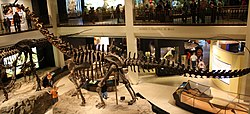Diplodocinae
| Diplodocines Temporal range: Late Jurassic to Early Cretaceous,
| |
|---|---|

| |
| Skeleton of Galeamopus | |
| Scientific classification | |
| Domain: | Eukaryota |
| Kingdom: | Animalia |
| Phylum: | Chordata |
| Clade: | Dinosauria |
| Clade: | Saurischia |
| Clade: | †Sauropodomorpha |
| Clade: | †Sauropoda |
| Superfamily: | †Diplodocoidea |
| Family: | †Diplodocidae |
| Subfamily: | †Diplodocinae Janensch, 1929 |
| Genera[1] | |
Diplodocinae is an extinct subfamily of diplodocid sauropods that existed from the Late Jurassic to Early Cretaceous of North America, Europe, Africa and South America, about 161.2 to 136.4 million years ago. Genera within the subfamily include Tornieria, Supersaurus, Leinkupal, Galeamopus, Diplodocus, and Barosaurus.[1]
Cladogram of the Diplodocidae after Tschopp, Mateus, and Benson (2015).[1]
References
- ^ a b c Tschopp, E.; Mateus, O. V.; Benson, R. B. J. (2015). "A specimen-level phylogenetic analysis and taxonomic revision of Diplodocidae (Dinosauria, Sauropoda)". PeerJ. 3: e857. doi:10.7717/peerj.857. PMC 4393826. PMID 25870766.
{{cite journal}}: CS1 maint: unflagged free DOI (link)












